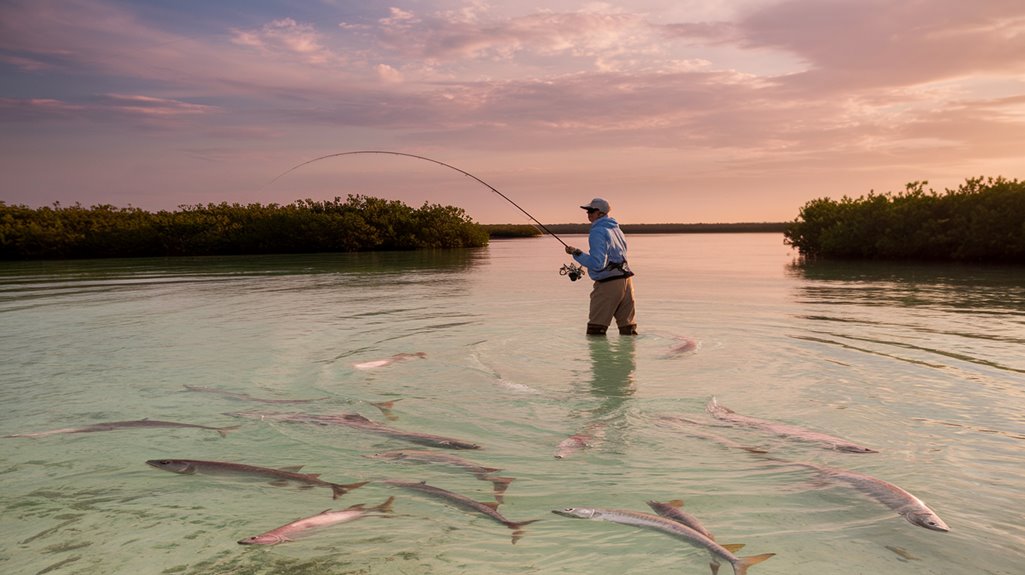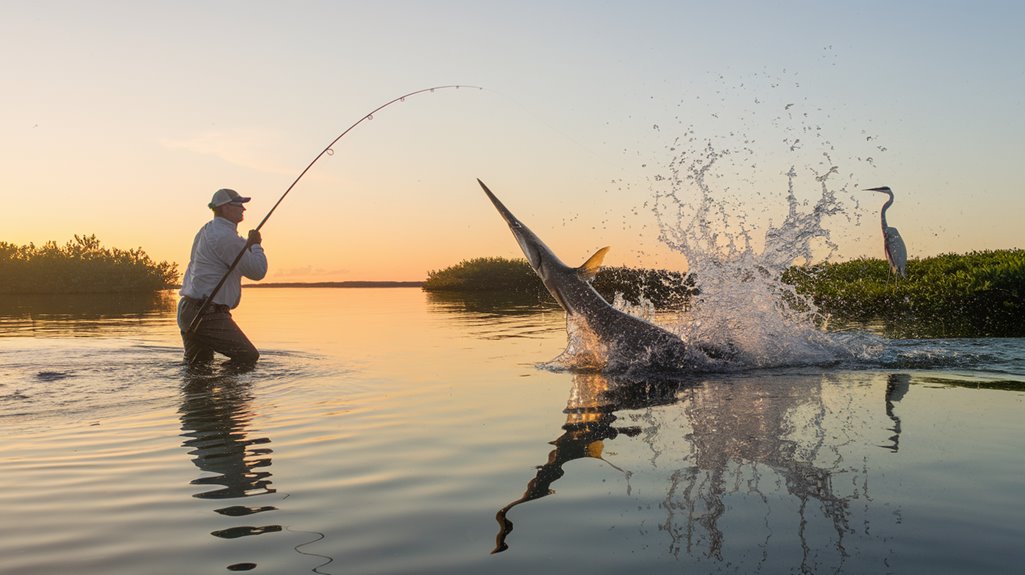You'll find tarpon fly fishing in Big Pine Key to be one of Florida's most challenging yet rewarding pursuits. These majestic "silver kings" patrol the crystal waters from mid-March through June, offering prime opportunities for skilled anglers. With fish regularly exceeding 100 pounds, you'll need precise technique and proper gear to succeed. The combination of ideal weather patterns, strategic locations, and specific tackle requirements creates a complex puzzle that's worth solving.
Key Takeaways
- Prime tarpon fly fishing at Big Pine Key occurs from March through June, with peak action during May's Worm Hatch.
- Use 10-12 weight fly rods with high-capacity reels and 40-80 pound fluorocarbon leaders for optimal tarpon handling.
- Target tarpon around Bahia Honda Bridge and No Name Key Bridge during incoming tides and early morning hours.
- Choose proven fly patterns like Tarpon Bunny or EP Tarpon Streamer in white, chartreuse, or black colors.
- Focus on turtle-grass flats and bridge structures, maintaining stealth and precise casting for the best results.
Essential Gear and Tackle Setup for Tarpon Success
When pursuing the mighty tarpon in Big Pine Key, you'll need to equip yourself with a robust 10-12 weight fly rod paired with a high-capacity reel that can withstand powerful runs from fish exceeding 120 pounds. Your fly fishing success depends on matching your line type to the conditions – choose a floating line for surface presentations or a sink-tip for deeper water targeting.
For ideal gear performance, select large, articulated flies or streamers in white, chartreuse, or black to match the baitfish tarpon target during their March-to-June migration. Don't overlook the importance of a strong 40-80 pound test fluorocarbon leader, which offers both abrasion resistance and reduced visibility. Complete your technical setup with polarized sunglasses, an essential tool for spotting these magnificent fish in varying water conditions.
Peak Seasons and Weather Patterns for Big Pine Key
Although tarpon can be found year-round in the Florida Keys, Big Pine Key's prime fly fishing season hits its stride from mid-March through June, with May emerging as the ultimate sweet spot. During this peak season, you'll witness the magnificent tarpon migration coinciding with the Worm Hatch, when 95% of anglers prefer to cast their lines.
Understanding local weather patterns is essential for your success. Early summer brings afternoon thunderstorms, typically moving west to east across the waters. Don't let this discourage you – the post-storm conditions often present excellent fishing opportunities with calm seas. If you're looking to avoid crowds, consider targeting tarpon in late June. While still within the prime window, you'll encounter less angler pressure, making the fish more likely to strike.
Proven Fly Patterns and Presentation Techniques
Successful tarpon fishing in Big Pine Key hinges on mastering both pattern selection and presentation techniques. You'll want to focus on proven fly patterns like the Tarpon Bunny, EP Tarpon Streamer, and Clouser Minnow, which effectively mimic their natural prey in various sizes and colors.
To maximize your success, position your cast ahead of moving tarpon and let your fly sink briefly before beginning your retrieve. You'll need to adjust your retrieve speed and pattern based on water conditions and the fish's feeding behavior. During peak migration months from March to June, maintain a stealthy approach and precise casting technique, as tarpon are exceptionally wary. Remember that proper presentation often matters more than pattern selection – even the best fly won't work if poorly presented.
Mastering the Hook Set and Fighting Methods
Mastering the tarpon hook set demands precise timing and technique to overcome their notoriously hard mouths. When you feel the subtle take, execute a swift, upward motion to guarantee solid hook penetration. Keep your rod tip elevated throughout the fight to maintain consistent pressure.
During the battle, you'll need to employ strategic side-stripping techniques to control the tarpon's direction and prevent entanglement with nearby obstacles. Be ready to adjust your drag settings instantly, as these powerful fish often make explosive runs. Timing and patience are critical elements of fighting tarpon successfully. As your fish launches into multiple aerial displays, stay focused and maintain steady pressure. Don't rush the fight – let the tarpon tire naturally while keeping tension on the line to prevent them from throwing the hook during their acrobatic jumps.
Best Locations and Tidal Considerations

When pursuing tarpon in Big Pine Key, you'll find the most productive fishing grounds among the turtle-grass flats, coral heads, and bridge structures, particularly from mid-March through June. The Bahia Honda Bridge and No Name Key Bridge stand out as premier locations, with Bahia Honda offering exceptional opportunities for large tarpon encounters.
For ideal success, time your fishing sessions with incoming tides when tarpon move into shallower waters to feed. You'll want to focus your efforts during early morning or late afternoon hours, as these periods typically showcase increased tarpon activity, with fish rolling visibly on the surface. Understanding the local tidal patterns and current flows is vital – they'll dictate where and when you'll find the most active fish. Position yourself strategically at these locations during prime tidal movements to maximize your chances.
Frequently Asked Questions
Where Is the Best Place to Fly Fish for Tarpon?
You'll find the best tarpon fly fishing at Big Pine Key's turtle-grass flats, coral heads, and under bridges like No Name Key and Bahia Honda, especially during May's Worm Hatch migration.
What Is the Best Month to Catch Tarpon in the Keys?
May is your prime month for tarpon fishing in the Keys, when you'll find peak migration patterns and the famous Worm Hatch. You'll get ideal conditions in shallow waters and flats.
What Weight Fly Rod Do You Use for Tarpon?
You'll want a 10 to 12-weight fly rod for tarpon, with 11-weight being ideal for most situations. It provides the backbone to handle big fish and cast heavy lines effectively.
Where Is the Best Place to Catch Tarpon in the Florida Keys?
With tarpon weighing up to 120 pounds, you'll find prime fishing at Big Pine Key's No Name Bridge and Bahia Honda Bridge, plus the surrounding turtle-grass flats during peak season from March to June.
Conclusion
You'll find it ironically fitting that after investing in top-tier gear and mastering technical casting skills, your success often hinges on the tarpon's unpredictable nature. While you've learned the precise tidal patterns at Bahia Honda and perfected your double-haul cast with a 12-weight, these magnificent fish might lazily roll past your perfectly presented fly. That's the technical mastery and humbling reality of tarpon fishing in Big Pine Key.

